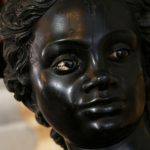Photo Journalism Venice after Second World War: Interfoto
Right after WW2, in 1946 a photographer involved in journalism and ex-partisan founded a photography agency in Venice. His name was Dino Jarach and the photography agency was called Interfoto. The international film festival, the Biennale as well as photos of contemporary artists, both Italian and not, portrayed while in their ateliers or with their masterpieces: this was his idea. And it worked! So much that when he left Venice to move to Milan in 1956, he worked with artists of the kind of Lucio Fontana, Emilio Vedova and Roberto Crippa.
After Jarach, the photography agency got even bigger thanks to Duilio Stigher. It collaborated with Associated Press and newspapers and magazines such as Gente, Oggi, Il Corriere della Sera, La Stampa, Il Giorno, L’Unità, Paris-Match, Der Spiegel, Time, Life. Divas from the movie industry while filming in Venice, but also everyday scenes of life in the Venetian lagoon were still the favourite subjects.
Journalism and photographers in Venice in the 1960s
And guess what? In the 1960s photos became the key for storytelling in journalism. Therefore, photographers of this Venetian agency started reporting about social protest, workers’ strikes, but even major events such as the Vajont tragedy in 1963. That night a massive landslide from the Mountain Toc fell into the water basin of the Vajont dam by the pre-Alps and generated a huge, incredibly fast tsunami which washed away a whole town, killing nearly 2,000 people sleeping in their homes. That night, the Venetian photographers Duilio Stigher and Walter Stefani were already there in the early hours of the day, taking more than 200 photos. More photos were taken also during the “acqua granda” on November 4th in 1966, when Venice experienced its highest high tide ever recorded in history.
Vittorio Pavan and his photography in Venice
I met the photographer Vittorio Pavan many years ago. He is now the one in charge of the archive of all the negatives produced by this photography agency, now named CameraPhoto Epoche. Vittorio has that capacity of disappearing behind the camera eye, discrete and discerning, as excellent photographers are. His preference for black and white photos always fascinated me.
Vittorio Pavan started collaborating with the agency at the age of 14 in 1972. Gifted in drawing, he soon learnt his new job. A team of seven people, three employees, very busy.
Sending photos to newspapers and magazines
How did they send to newspapers their pictures at that time? They used the “telephotography” or wirephotos, which consisted in sending a photo by telephone. Vittorio told me that in order to be the first ones sending the photo, they developed the film and printed a 13x18cm large photo while the film was still wet. Then, you had to glue the photo on gummed paper with a caption, you ran to the post office where they used a roller, a sort of a rudimental scanner, that read dot after dot and transmitted everything.
And to magazines? When sending a photo to magazines, no major rush was needed. The photo size was 18×24 and in the evening you had to go to the train station and reach the post wagon. You sent your photo “out of the sack”, which meant not as ordinary mail, but outside the mail sack, directly in the hand of the postman.
It does not sound easy. And yet, in the journalism world of those years, photos were almost more important than texts!
At the age of 16 he was the one in charge of printing the photos in black and white. His first photo was then posted in the newspaper of the Communist Party, L’Unità, in 1974 and it witnessed a workers’ strike.
Photography for reproductions of Fine Art
Four years later a turning point for this photography agency of Venice: no longer just photojournalism, but also fine art reproductions. Is it clear what this means in a city like Venice?
Eventually this became the main trend. In 1987 Vittorio Pavan and Gianpietro Codato took over the agency and the collaboration with major publishing houses specialised in fine art became very demanding: Treccani, Electa, Magnus, Biblos, Art Resource, Goro int. Press, Orion Press etc.
For ten years in a row Vittorio photographed all the art works in the Doge’s Palace under the supervision of Umberto Franzoi, the director of the museum. Not sleeping for ten years… yes, you got it: he certainly could not photograph the art works during the museum opening hours, but at night time. He also developed a way to take a photo of the art works, avoiding glare or shadows. Vittorio told me
“… the frame of the Apotheosis of Venice by Paolo Veronese in the Major Council Hall in the Doge’s palace is almost a meter thick and easily casts shadows on the work!”
The archive of CameraPhoto Epoche in Venice
In 2000 the fine art reproductions’ database and the historical archive split and Vittorio Pavan decided to take care of the latter, which, he says, is unreproducible.
His studio in calle del Caffettier is open to public and here is his website: www.archiviocameraphotoepoche.com
You enter the place and hundreds and hundreds of acid-free, cardboard boxes are piled on shelves no high water can reach. Inside these boxes more than 320,000 negatives of photos in black and white are archived and filed. Mainly photos dating back to the time 1946-1987, but some are older, such as the ones witnessing Mussolini’s death. You can find photos portraying Braque, Carrà, Chagall, Dal, Fontana, Giacometti, De Chirico, Guttuso, Leger, Mirò, Morandi, Picasso and Vedova or Pasolini, Pound, Hemingway, Stravinsky, Fellini, John Ford, Sergio Leone, Akira Kurosawa, Mario Soldati, Michelangelo Antonioni… where else?
As Francesca Meneghetti and Marco Maria Polloniato well pointed out in their report,
“CameraPhoto Epoche is the first Venetian photography agency that was exclusively formed and run by photographers involved in journalism, covering all the phases involved in creating a photo reportage.”
In 2013 and 2014 the archive was officially labeled of regional and national cultural interest by the Regione Veneto and the Minister of Cultural and Historical Heritage in Italy.
The emergency to save the archive
But the negatives are deteriorating. The cellulose acetate they are made of is unstable and because of acetic acid, it might also bring to spontaneous combustion. Last year the crowdfunding project did not succeed, but something has to be done. At least scanning the negatives. Otherwise it will be a loss of our recent history and its protagonists.
by Luisella Romeo
registered tourist guide in Venice, Italy
www.seevenice.it
(on the cover, Gondolas covered in snow in Venice, 1956, ArchivioCameraphoto/©Vittorio Pavan, Venice)














Very interesting Luisella
Thank you! Glad you liked it!